WEDNESDAY AT PHOTOKINA
Sixty Years of Peace
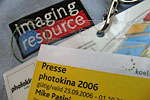 By MIKE PASINI
By MIKE PASINI
Editor
The Imaging Resource Digital Photography Newsletter
COLOGNE, Germany -- The innovation we saw yesterday in the latest crop of digital cameras was not mirrored today in our tour of software to manipulate the images those cameras can capture. But software evolves more than innovates and, not surprisingly, the software that drew our attention today was the innovative stuff we were already familiar with.
|
Fluid Mask |
Old news? But old news has its function, too, we thought. But you'll have to read to the end to see precisely what we mean.
Meanwhile, here a few things we found worthwhile. We have a few more visits to this sector planned, so stay tuned for updates.
We're always looking for a masking program that can easily lift a heady with wild hair off a complex background and put it seamlessly onto a new background. It's almost become a fairy tale, with one after another knight in shining armor turning out to be a squeaky squire with some intolerable curse.
We spent a little time at the Vertus booth watching the demo of Fluid Mask (http://www.vertustech.com). Vertus is actually the software division of Heligon, which specializes in image data interpretation. The company uses "complex algorithms to mimic the way the eye and brain perform visual processing so that complex shapes and colors can be recognizes in images."
Fluid Mask is its cross-platform Photoshop plugin to automatically identify object edges. Once you see the sections of an image, you select them to make a mask. You fine tune the selection by painting over transparent areas.

Fluid Mask. Masking in action (l) yields a yellow keyed dropout with transparency on the dress.
So for our hypothetical wiry hair girl, the program would identify the background, we'd select those background areas and then we'd paint around her hair flowing strand by strand into the background. In a few seconds, we'd have isolated her from the background and be able to drop any background behind her.
The demo was impressive. But so was the price at $199. But these kinds of tools are always pricey.
We happened to bring our antique canvas Domke camera bag to Cologne and have used it to gather press materials and pack a couple of digicams to shoot floor shots. The company is celebrating its 30th anniversary and we expect our antique to hold up for the 60th, too.
But it was built for a different era. And we've been curious what the ideal bag for a dSLR would look like. That's a personal decision, great for late night debates, but we've noticed most of our colleagues not using bags at all, just strapping those $3,000 wonders over their shoulder. That keeps the gear ready to shoot, but what if you want some convenience, too?
Lowepro (http://www.lowepro.com) has always intrigued us as one possibility, so we spent some time at their stand looking primarily at two models, a Stealth Reporter that resembled our Domke and a SlingShot. Both addressed the equipment needs of a digital setup quite nicely, we thought.
The SlingShot, available in two sizes, is a backpack with a single strap that you duck into. You secure it with a second strap on the opposite side until you want to shoot. Then you pop off the second strap, swing the back under your arm from your back and, in the horizontal position, pop its side (and your top) flap open. That gives you easy access to your dSLR with as long a lens as you like (pointing down).

Lowepro. The SlingShot ready for action and a Stealth Reporter.
A top pocket holds accessories and there are interior pockets that are designed to carry media. There's also room in the main compartment for several other lenses. And if you need more, there are two belts that hold Lowepro's attachable small bags. And if the big bag is too big, there's a smaller version, too. Very nicely thought out.
But what, we asked, if you want to carry a tripod. That would make it hard to swing the bag from your back to your belly, so you really want something more like the Stealth Reporter.
This model resembles the more traditional shoulder bag, but is designed to carry everything from image viewers to laptops, too. With weather protection, a hidden passport pocket and a 12-card media wallet, you might not think you need the attachment loops, too. But Lowepro's got you covered.
Quality was excellent and the bags were lightweight, too. But what really stood out was the design. There was a place for everything and a bag for every need.
GORILLA POD | Back to Contents
Another little gizmo caught our eye. We like to use a little C-clamp mini tripod for those situations where we want to mount our camera but can't squeeze a full-size tripod into the space. But it's a clamp. You need something to clamp it to and that something can't be wider than a couple of inches. So it often isn't quite right.
Enter the Gorilla Pod (http://www.joby.com).

Gorilla Pod. A gripping way to add support where there is none.
Made in three sizes -- one for digicams (12.5 oz. maximum), a larger one for dSLRs (2.5 lbs.) and a pro model that can take 4.5 lbs. -- the Joby Gorilla pod has a quick release mount attached to three legs made of interconnected balls that can wrap around and lock to any surface. That beats the C-clamp, we thought.
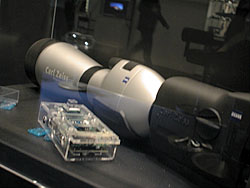
Zeiss Scope. With Optics Pro corrections built into it for correction inline images.
At the DxO Labs stand, Deborah Gallin-Soussan gave us a tour of the latest Optics Pro, which can dramatically improve the quality of images taken by dSLRs and advanced digicams. How? By elimination lens distortion, vignetting and softness. And then removing noise and purple fringing. And optimizing exposure and dynamic range, too.
It does this by referring to a database of lens and sensor characteristics that the company compiles for an extensive list of cameras and lenses. When you buy the program, you get the entire database, plus updates as they become available.
Version 4 for Windows is available now and the PPC and Intel Mac release is expected to be available for download at the end of October.
Two things we wanted to see were the distortion correction and multipoint color correction. And Deborah Gallin-Soussan generously demoed them for us.
The distortion correction feature was originally suggested to the company by wedding photographers unhappy with group shots taken with a wide angle lens that distorted the faces of those on the edges of the group. It leaves the center of the image alone and narrows the two sides in a graduated effect so more narrowing occurs the further from the center the image is.
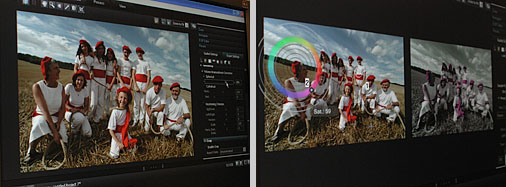
Optics Pro. Distortion fixed (l) and color replaced (r) on a sample image in the blink of an eye.
Multipoint color correction allows you select up to four colors in the image and replace them with any other four, adjusting various parameters to fine tune the effect.
Both were very easy to use, fast and effective. We've made arrangements to review this powerful tool shortly.
NIK SOFTWARE | Back to Contents
Nils Kokemohr is Nik Software's chief technology officer. He's also the guy who invented:
- Dfine, the company's noise reduction software (reviewed in the Aug. 8, 2003 newsletter at http://www.imaging-resource.com/IRNEWS/index-arch.html)
- Sharpener (http://www.imaging-resource.com/SOFT/NS/NS.HTM) and Sharpener Pro 2.0 (http://www.imaging-resource.com/SOFT/NS2/NS2.HTM)
- the U Point technology used in Nikon's Capture NX (http://www.imaging-resource.com/SOFT/NX/NX.HTM), the demo of which was downloaded over 750,000 times, according to Nik's Tony Corbell.
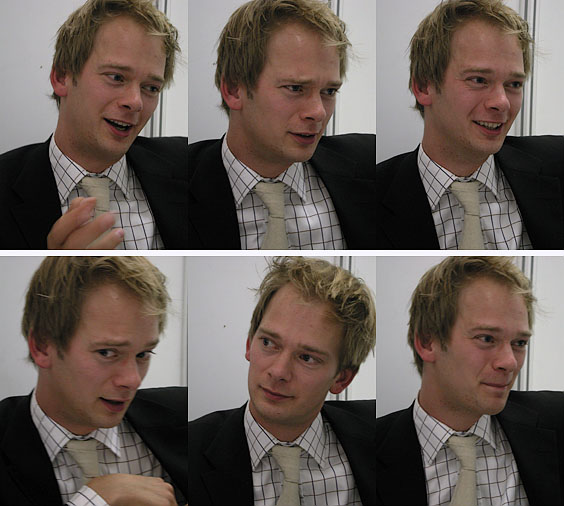
Nils
Our crew actually sat down with Nils as he demonstrated how to change a daylight into a night image using just a handful of U Points. Our shot doesn't do it justice, taken from the side, but you get the idea. Try doing that with just six clicks of your mouse in Photoshop. Plus, it was "more fun" using U Points, as Nils pointed out.
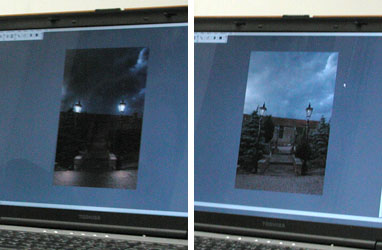
U Point Day for Night
Shortly after finishing our report last night at midnight here, we took a stroll around the rather large block on which the hotel is built, hoping to drain every last bit of energy and sleep soundly.
Our stroll passed through an area thoroughly bombed by the Allies in the second World War. On both sides of the street were post war apartment buildings, bicycles leaning against them and small cars parked along the sidewalk. Occasionally someone passed by us on the way home, each of us minding our business.
We were a little apprehensive about a late night stroll. Would we scare people? Would people scare us? But we needed it. Then a strange thing happened.
As we passed under an opened window, we heard someone cough twice. The familiar sound seemed almost like a greeting at that late hour. We Germans are just like you, it seemed to say. Pass in peace.
Today, we dashed from our meeting with Nils Kokemohr to the Lord Mayor's speech opening the photo exhibition titled Sixty Years of Peace. We listened to his speech in German without understanding it, saw a few dignitaries sign the "guest book" on the bottom of one of the large canvas prints and prepared to go back to the hotel to write our daily report. Then Jean Mohring, director of the German-Dutch Society based in Cologne, asked if anyone in the audience had not understood what had been said.
We raised our hand, honest to a fault.
Jean bounded off the stage and came over to fill us in. The Lord Mayor had cited the urgent need for world peace, alluding to the trial of the two Lebanese who attempted to bomb the Cologne train system at the end of July (http://www.spiegel.de/international/1,1518,433382,00.html). Cologne itself is sister city to some 23 other cities, including Tel Aviv and Bethlehem, he pointed out, and hoped to persuade both sides that there's a better way. The exhibit itself is about just that subject, he explained. The advantages of peace.
Originally exhibited at City Hall in the Holy Year, the exhibit was then seen by some 6,000 visitors.
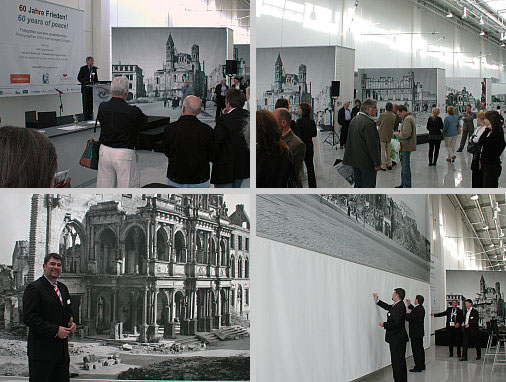
60 Years of Peace. Cologne reminds the World with images of the price of war. Lord Mayor addresses the crowd assembled to see the row of huge canvas images. Jean stands before an image of City Hall (bottom left) and signs the 'guest book' (bottom right).
The images were shot in the late 1940s after World War II by Karl Hugo Schmolz, an architecture photographer who died in 1986, with an 8x10 wooden view camera and glass negatives. At that time, it was difficult to get chemicals and hard to get around the city. But Schmolz persisted in photographing Cologne's story. The large reproductions have an erie, almost 3D detail. And the story they tell is one of rubble and destruction, centuries-old beauty annihilated -- in short, the cost of war.
"Churchill did us a favor," Jean told us. "He said, 'Destroy everything but the cathedral.'" And, indeed, within a five mile radius of the cathedral -- where had been walking when we heard the cough -- everything had been leveled.
Now Cologne wanted to spread the message that peace is a good thing. "Look" at this rubble, he warned, "and be careful. Be friends."
We coughed politely, thanked him, and went on our way.